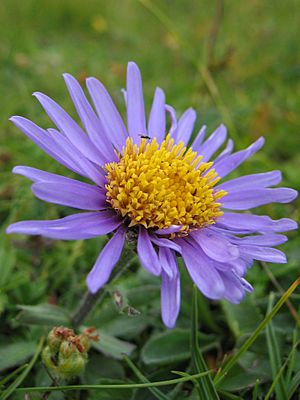Alpine aster facts for kids
Quick facts for kids Alpine aster |
|
|---|---|
 |
|
| Conservation status | |
| Scientific classification | |
| Genus: |
Aster
|
| Species: |
alpinus
|
| Synonyms | |
|
|
Aster alpinus, the alpine aster or blue alpine daisy, is a species of flowering plant in the family Asteraceae, native to the mountains of Europe (including the Alps), with a subspecies native to Canada and the United States. This herbaceous perennial has purple, pink, or blue flowers in summer.
Description
Aster alpinus is a caespitose herbaceous perennial that grows 10-35 cm tall. The bloom color may be blue, indigo, violet, white, or pink. In the UK this plant has gained the Royal Horticultural Society's Award of Garden Merit.
Distribution and habitat
It grows very slowly in clay, silt, loam, silty clay, and sandy clay. Its minimum pH scale is 6 and maximum pH scale is 7.5. It grows erectly in a "single crown" form.
It does better in generally cooler climates. Usually it is adapted to clay, silt, loam, silty clay, sandy clay, clay loam, silt loam, sandy loam, silty clay loam and sandy clay loam soils, and prefers low fertility. The plant can tolerate only a minimum temperature of -28 °C / -18.4F after the occurrence of cell damage. It can survive medium heat of fire and requires at least 90 frost free days for proper growth.
Ecology
It is herbaceous and attractive to bees, butterflies, and birds.
Conservation
NatureServe lists variety Aster alpinus var. vierhapperi as Secure Variety (T5) in Canada, but Critically Imperiled (S1) in Ontario and Vulnerable (S3) in Alberta. In the United States, it is Critically Imperiled (S1) in Colorado and Wyoming.
See also
 In Spanish: Aster alpinus para niños
In Spanish: Aster alpinus para niños



